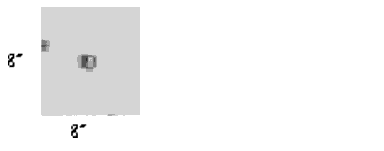



The following are examples of how to determine the acquisition scenario, and how to derive the correct exposure times. Each example shows an image of the target, the input parameters for the Exposure Time Calculators, and the parameters that you will need to provide in your Phase 2 proposal.
In this first example an isolated V = 19 mag QSO (z = 1.5) is to be acquired, with the scientific exposures to be obtained in the 52X0.5 slit.

The target is isolated, so it will be acquired with a point source acquisition. The object is faint, so we can use the preferred F28X50LP filter. The TA ETC is then used to determine an exposure time of 11.4 seconds. Note that the GAIN=4 and CR-SPLIT=1 must be used for the ETC to ensure that you have a S/N of at least 40 in each of the two images obtained during the ACQ process. The object does not saturate the CCD, and the exposure time is less than 5 minutes, so we have devised a valid target acquisition. Given that the exposure time is so short, we can lengthen the time to 15.0 seconds (which yields a peak value of 1600 electrons, well below saturation) to make certain we have enough signal for a good acquisition. Since the data are being obtained in a wide slit, we do not need to perform an ACQ/PEAKUP, and our acquisition is complete.
Target Acquisition ETC Parameters - ACQ
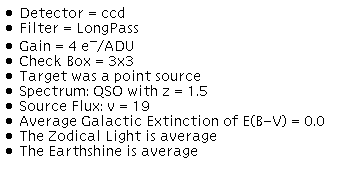
Phase 2 Parameters for ACQ Exposure

In this example-point source acquisition of a bright, isolated object with a CCD dispersed light peakup-an isolated V = 3.5 mag M2 I star is to be acquired, with the scientific exposures to be obtained in the 0.2X0.06 echelle slit.
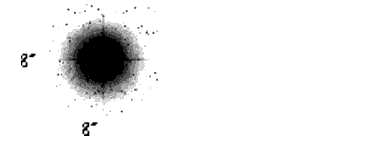
The scientific target will be acquired with a point source acquisition, but because the object is so bright, we cannot use the preferred F28X50LP filter. Instead, we will use the F28X50OII filter, and the Target Acquisition ETC yields an exposure time of 0.06 second, which is less than the minimum allowed time of 0.1 second. Note that the GAIN=4 and CR-SPLIT=1 must be used for the ETC to assure that you have a S/N of at least 40 in each of the two images obtained during the ACQ process. We will therefore increase the exposure time to 1.0 second. The object does not saturate the CCD, and the exposure time is less than 5 minutes, so we have devised a valid target acquisition.
The data are being obtained in a narrow slit, so we need to perform an ACQ/PEAK acquisition. The target is far too bright to perform the peakup with the MIRROR, so we will do a dispersed light peakup. Since we cannot perform a CCD peakup with an echelle grating, we will use the G430M grating with the CCD and the program slit (0.2X0.06); note that for an ACQ/PEAK, this combination is legal. The best approximation of this slit available in the Spectroscopic ETC is 52X0.05 (the correction to a shorter slit). For a 1 second exposure with 1x1 binning, the ETC gives a peak count of 1880 electrons (well below saturation) and a total count of 2.5x106 electrons (30 times the recommended minimum).
Target Acquisition ETC Parameters - ACQ
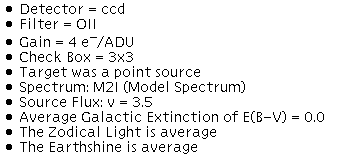
Spectroscopic ETC Parameters - ACQ/PEAK
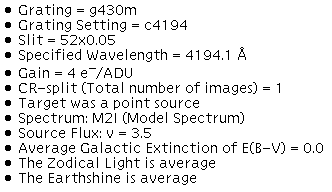
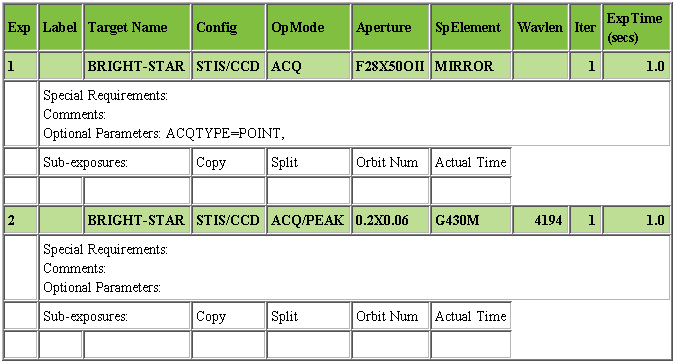
In this example an isolated galaxy with a flux of 1.5x10-14 erg cm-2 s-1 Å-1 arcsec-2 at 8000 Å is to be acquired, with the scientific exposures to be obtained in the 52X0.2 slit.
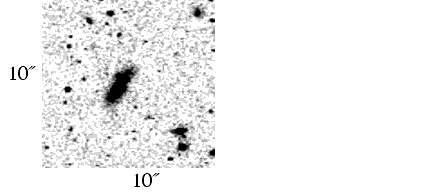
The target is isolated, so it will be acquired using a diffuse-source acquisition. After trying various checkbox sizes in the TAS (the image is from WFPC2), we determine that the appropriate CHECKBOX size is 9, and that we will use the FLUX-CENTROID algorithm. The object is faint, so we can use the preferred F28X50LP filter. The TA ETC is then used to determine an exposure time of 0.21 second. Note that the GAIN=4 and CR-SPLIT=1 must be used for the ETC to ensure that you have a S/N of at least 40 in each of the two images obtained during the ACQ process. The object does not saturate the CCD, and the exposure time is less than 5 minutes, so we have devised a valid target acquisition. Given that the exposure time is so short, we can lengthen it to 2.0 seconds to make certain we have enough signal for a good acquisition. Since the data are being obtained in a wide slit, we do not need to perform an ACQ/PEAKUP, and our acquisition is complete.
Target Acquisition ETC Parameters - ACQ
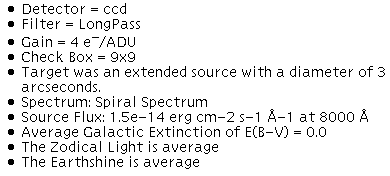
Phase 2 parameters for ACQ exposure
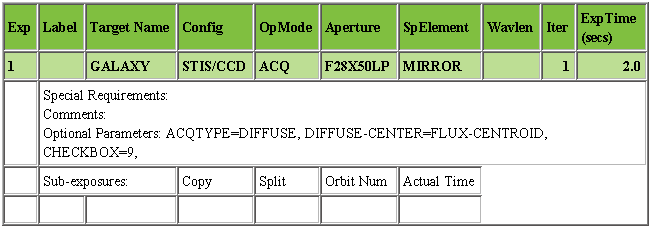
In this example a V = 19 mag nova in a field with a brighter companion is to be acquired, with the scientific exposures to be obtained in the 52X0.1 slit. We have a spectrum of the nova that we will use to perform the exposure time calculations, according to the ETC instructions.
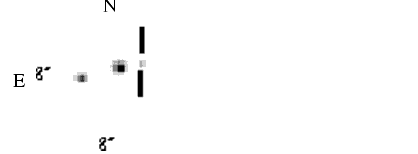
The target is in a crowded field and the on-board acquisition procedure will acquire the brightest object in the field, not our target. If a ground-based image were the only image of this field available and the spectral types of the neighboring stars were unknown, then an isolated offset star outside of the immediate field of the nova would need to be acquired. However, the above image was obtained with WFPC2 and the F555W filter, which has a similar bandpass to the STIS F28X50LP filter. We therefore know that the object to the southeast of the nova is clearly the brightest object in the field (V = 16.5), and it will be our acquisition object. The object is faint enough that we can use the preferred F28X50LP filter. Since we do not know the spectral type of the acquisition star, we will make a worst-case (i.e., fewest counts) assumption that the star is of spectral type O5 and unreddened. The Target Acquisition ETC is then used to determine an exposure time of 2.0 seconds. Note that the GAIN=4 and CR-SPLIT=1 must be used for the ETC to ensure that you have a S/N of at least 40 in each of the two images obtained during the ACQ process. The object does not saturate the CCD, and the exposure time is less than 5 minutes, so we have devised a valid target acquisition. Note that since we do not know the spectral type of the object, we need to confirm that if the star had a spectral type of M6 V (which gives the most counts in the F28X50LP bandpass), it would still not saturate. Given that the exposure time is so short, we can lengthen it to 3.0 seconds to make certain we have enough signal for a good acquisition.
After acquiring the offset star, we need to slew the telescope to the nova, and since the data will be taken with a narrow slit, we need to perform an ACQ/PEAK acquisition. The peakup will be performed in the program slit (52X0.1), and we will use the CCD and the MIRROR. A 1 second exposure with 1x1 binning yields 655 electrons in the central 25 pixels of the target, so an exposure time of 8 seconds yields 5240 electrons, which meets the minimum requirement of 5000 electrons. We need to lengthen the exposure time by a factor of 1.5 to account for the slit throughput (see Chapter 13), for a time of 12.0 seconds, and then lengthen this time to 20 seconds to ensure getting more than the minimum required. The object does not saturate the CCD, and the exposure time is less than 7.6 minutes (the maximum time for a peakup with the 52X0.1 slit), so we have devised a valid peakup target acquisition.
Target Acquisition ETC Parameters - ACQ
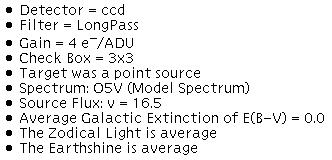
Imaging ETC Parameters - ACQ/PEAK
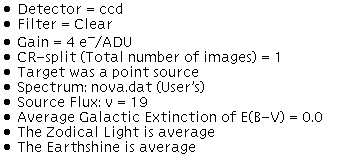
Phase 2 Parameters for ACQ and ACQ/PEAK exposures
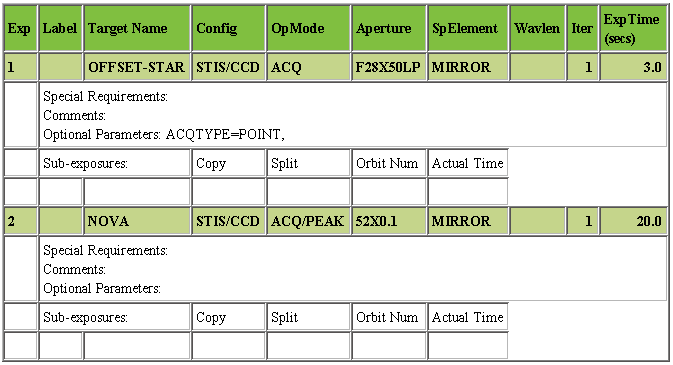
In this example an isolated V = 16.5 mag QSO (z = 0.2) is to be acquired, with the scientific exposures to be obtained with the QSO behind the 52X0.2F1 fiducial bar.

The target is isolated, so it will be acquired using a point source acquisition. The object is faint, so we can use the preferred F28X50LP filter. The Target Acquisition ETC is then used to determine an exposure time of 2.2 seconds. Note that the GAIN=4 and CR-SPLIT=1 must be used for the ETC to ensure that you have a S/N of at least 40 in each of the two images obtained during the ACQ process. The object does not saturate the CCD, and the exposure time is less than 5 minutes, so we have devised a valid target acquisition. Given that the exposure time is so short, we can lengthen it to 3.0 seconds to make certain we have enough signal for a good acquisition.
The QSO is to be placed behind a fiducial bar, so to ensure an accurate centering we will perform an ACQ/PEAK acquisition. The peakup will be performed in the 52X0.2F1-R slit. This peaks up the target at the offset reference position (see Barred Spectroscopy). Peakdown acquisitions are not recommended. We will use the CCD and the MIRROR. A one-second exposure yields 5130 electrons in the central 25 pixels of the target, and correcting for the aperture throughput (80%) yields 4100 electrons; note that the Imaging ETC must be used for this calculation. We thus require slightly longer than 1 second to obtain the minimum requirement of 5000 electrons in the target, so we can expand our final exposure time to 5.0 seconds. The object does not saturate the CCD, and the exposure time is less than 9.8 minutes (the maximum time for a peakup with the 52X0.2 slit), so we have devised a valid peakup target acquisition.
Target Acquisition ETC Parameters - ACQ
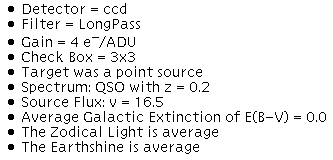
Imaging ETC Parameters - ACQ/PEAK
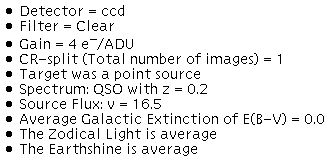
Phase 2 Parameters for ACQ and ACQ/PEAK exposures
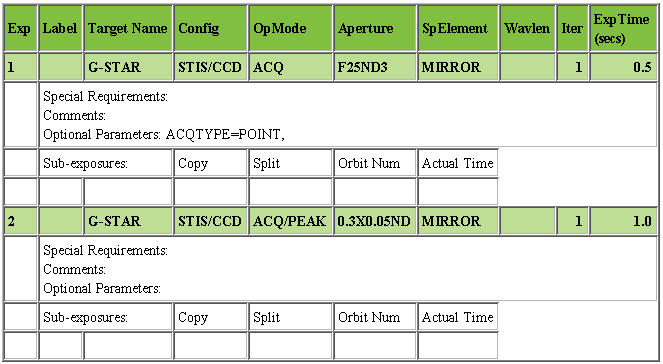
In this example an isolated V = 6.0 mag G2 V star is to be acquired, with the scientific exposures to be obtained with the star behind the WEDGEA1.8 mask.

The target will be acquired with a point source acquisition, but because the object is so bright, we cannot use the preferred F28X50LP filter. Instead, we will use the F25ND3 neutral-density filter, and the Target Acquisition ETC yields an exposure time of 0.02 second, which is less than the minimum allowed time of 0.1 second. Note that the GAIN=4 and CR-SPLIT=1 must be used for the ETC to assure that you have a S/N of at least 40 in each of the two images obtained during the ACQ process. We will therefore increase the exposure time to 0.5 second. The object does not saturate the CCD, and the exposure time is less than 5 minutes, so we have devised a valid target acquisition.
The star is to be accurately placed behind the WEDGE which is 1.8" in size, so we need to perform an ACQ/PEAK acquisition. The peakup will be performed in the 0.3X0.05ND slit (peakdown acquisitions are not recommended), and we will use the CCD and the MIRROR. A 1 second exposure yields 47,000 electrons in the target after you correct it for the aperture throughput [both the neutral-density (10-3) and the slit throughput (55%)]; note that the Imaging ETC must be used for this calculation. We have more than the minimum requirement of 5000 electrons in the target, the object does not saturate the CCD, and the exposure time is less than 6.4 minutes (the maximum time for a peakup with the 0.3X0.05ND slit), so we have devised a valid peakup target acquisition.
Target Acquisition ETC Parameters - ACQ
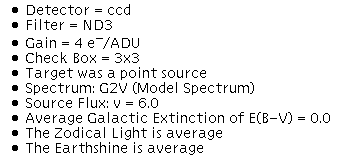
Imaging ETC Parameters - ACQ/PEAK
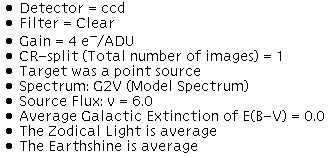
Phase 2 Parameters for ACQ and ACQ/PEAK exposures



|
Space Telescope Science Institute http://www.stsci.edu Voice: (410) 338-1082 help@stsci.edu |